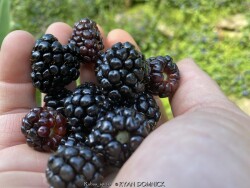

Blackberry (Rubus sp.) is an "easy to grow" edible fruit that is worth growing in Kansas. Store-bought blackberries are expensive and don't taste as good as garden grown fruits. All cultivars of blackberries have perennial roots, but most top shoots only live for two years. (meaning shoots grow in the first growing season and fruits grow on those shoots during the second growing season) The cycle is repeated; maintenance involves removing old canes after decline or death. Raspberries are vigorous and can be locally invasive in the garden but rarely invasive in the wild. They propagate by basal shoots (also known as suckers) spreading some distance from the main plant. After establishment, it is high maintenance if it has already filled the space and you don't want it to spread any further so plan accordingly. In the landscape, raspberry and blackberry mix well into garden designs with ornamental plants as long as you create it's own area (like a background fence to train plants on) The main difference between raspberry and blackberry are that the fruit releases from the raspberry differently. The "torus" or inside center of the fruit is hollow and releases from the stem with raspberry. With Blackberry, the "torus" or center "picks with" the fruit giving a solid fruit to eat. (just in case you have always wondered) Our supplier, Forrest Keeling nursery, has released an array of improved hybrids and varieties available.


***Description for this perennial available with future update!*** Rudbeckia 'American Gold Rush' is also known as American Gold Rush Black-eyed Susan >>>>>>>>>>>>All Proven Winners® plants are legally propagated, healthy and vigorous, true to name, and tagged with color pictures and growing information.


***Description for this perennial available with future update!***Fulgida Native Black-eyed Susan, is also known as Rudbeckia fulgida var. Fulgida
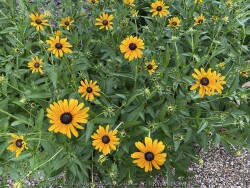

***Description for this plant available with future update!*** Rudbeckia fulgida var. umbrosa is also known as Appalachian Black-eyed Susan>>>>>>>>>> Good variety for customers with irrigation systems that water too much for other Black-eye Susan varieties.
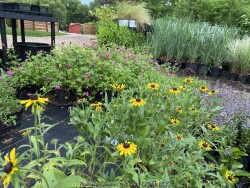

***Description for this perennial available with future update!***Native Black-eyed Susan, is also known as Rudbeckia hirta
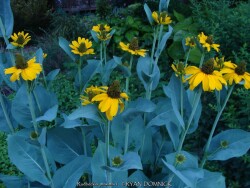

***Description for this perennial available with future update!***Great Coneflower / Blue-Leaf Coneflower, is also known as Rudbeckia maxima
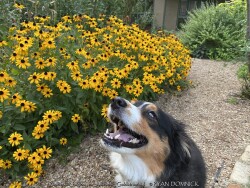

***Description for this plant available with future update!*** Rudbeckia sp. is also known as Black-eyed Susan.


Wild petunia is a native wildflower with bright lavender-pink flowers occurring in a wide swath from Texas to Michigan and the mid-west including Kansas Native habitat includes poor and rich soil prairies and lightly shaded woods. This wildflower also colonizes readily, will grow under the lawnmower blades and can be found along state highways. Foliage is often green and attractive. Flowering is relatively short at 2 to 4 weeks but gorgeous while it happens. Seed pods develop eventually break open to release seed. In the landscape, Wild petunia can be used in any average to dry soil situation including berms, hot south or west side of the house, or any other full to part-sun area. These will grow in poor rocky, sandy or clayish soils and even rich organic soils with slightly increased root rot susceptibility. With our average 40 inches of rain per year in eastern Kansas, extra irrigation is not recommended. Wild petunia can grow and flower in part shade even dry shades situations with a few hours of angled sun. It can also be planted in parking lot medians and other hell strips as a very durable groundcover as witnessed on Nebraska University's Lincoln campus. Combine with any other flower colors except lavender. There is quite a lot of diversity within the species so plants from different locales will have different foliage adapted to the site. Un-wanted self-seeding can be a problem in the garden if you do not use mulch. This is generally encouraged in wild gardens, however.
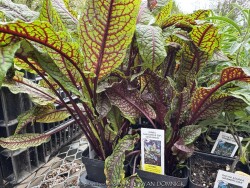

***Description for this perennial available with future update!*** Rumex sanguineus var. sanguineus is also known as Bloody Dock or Red-Veined Sorrel.
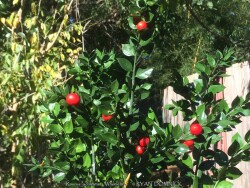

Wheelers Butcher's Broom (Ruscus aculeatus 'Wheelers') is the ultimate dry-shade plant for eastern Kansas landscapes. They are native to dry shaded woodland and hedgerows in England and along coastal cliffs. Butcher's Broom has everything a shade gardener might ask for; dependable dark green foliage, colorful red long-lasting fruits, evergreen during winter, and ease of care with very low maintenance. "Leaves" are actually "cladodes" (flattened, leaf-like stem tissue that photosynthesises) Evergreen foliage is bristly, shrub-like, and hardy to about -10°F. If it gets colder than that, ruscus will be deciduous and will slowly recover in summer. The red berries which sit squarely on the middle of the "leaves" on established plants persisting for a few months through the fall! Ruscus tolerate deep shade but some filtered or morning sun is best for optimal growth in our colder climate. With prickly foliage, these plants resist deer and rabbit browsing. Ruscus tolerates most soils except for poorly drained ones. Growth is quite slow with young plants but speeds up with establishment and rich soils with regular water. It is best to start with large plants as establishment and full winter-hardiness will occur much faster. A thick layer of mulch greatly helps with cold hardiness. Established plants have thrived in our Lawrence Kansas zone 6a display garden for over 10 years enduring temperatures as low as -18°F. Ruscus aculeatus 'Wheeler's' is self-fertile, not needing a male plant for pollination.


Hardy Dwarf Palmetto (Sabal minor) is among the world's most cold-hardy palms and spread over a large geographical area in the Southeast USA. Green foliage is waxy and fan-like; typical of any fan palm. When grown in a northern climate such as Kansas, growth is pretty slow at first and some winter damage should be expected if temperatures drop below -5 degrees F. It is advisable to mulch the crown of a newly planted Sabal minor with 6 to 8 inches of mulch for the first few years. Established plants get about 2 to 3 feet tall after 10-20 years. Sabal minor tolerate excessive moisture and rain gardens but prefer rich well-drained soil. Sabal minor needs full sun and a hot and humid (Kansas) summer to build up stored energy for the next winter. They are also notably drought tolerant if established and grown in full sun. Useful in the landscape as a tropical looking evergreen specimen plant. Unlike other Evergreens, needle palm maintains bright green foliage, not dingy olive green like many conifers. Combine with just about any other flowering plants and most garden themes. This true palm, however, is a must for any tropical theme garden. Mix with hardy banana (Musa basjoo), canna, or crinum lily! Growth is quite slow with young plants but speeds up with establishment and rich soils, regular water, and full sun. It is best to start with large plants as establishment and full winter-hardiness will occur much faster. A thick layer of mulch greatly helps with cold hardiness. South or West exposure is best. Sabal minor 'Lawrence' was named by Plant Delights Nursery after Ryan Domnick (the Author) growing it on the South side of a building in Lawrence, KS in 2013 with no mulch. The origin of the original plant (actually 2 plants) is a mystery but new seed has been collected every year since. Seedlings of this survivor plants are sold as Sabal minor 'Lawrence'. After confirmation in fall of 2021, the original plants are still thriving and setting seed after the worst winter in 30-50 years. During that arctic blast of February, 2021, lows down to -17 degrees F on Feb 16th, 2021 were recorded. The longevity of this cold blast was also impressive: 10 days on a row with highs of 10-15 degrees F or lower, 8 nights of lows in the single digits and negatives, and 36 straight hours of 0 degrees F and mostly lower. The two established specimens survived with varying degrees of foliage damage but with complete recovery by summer and 5-7 fully formed leaves by fall. It is estimated they have been in the ground since 2011-2012 and are 2-3' tall. Repeated or successive cold winters with complete foliage loss can be an issue with this and many evergreen zone 6/7 plants. One occasional difficult winter followed by mild winters is more tolerable. Avoid North-facing exposures.


Hardy Dwarf Palmetto (Sabal minor) is among the world's most cold-hardy palms and spread over a large geographical area in the Southeast USA. Green foliage is waxy and fan-like; typical of any fan palm. When grown in a northern climate such as Kansas, growth is pretty slow at first and some winter damage should be expected if temperatures drop below -5 degrees F. It is advisable to mulch the crown of a newly planted Sabal minor with 6 to 8 inches of mulch for the first few years. Established plants get about 2 to 3 feet tall after 10-20 years. Sabal minor tolerate excessive moisture and rain gardens but prefer rich well-drained soil. Sabal minor needs full sun and a hot and humid (Kansas) summer to build up stored energy for the next winter. They are also notably drought tolerant if established and grown in full sun. Useful in the landscape as a tropical looking evergreen specimen plant. Unlike other Evergreens, needle palm maintains bright green foliage, not dingy olive green like many conifers. Combine with just about any other flowering plants and most garden themes. This true palm, however, is a must for any tropical theme garden. Mix with hardy banana (Musa basjoo), canna, or crinum lily! Growth is quite slow with young plants but speeds up with establishment and rich soils, regular water, and full sun. It is best to start with large plants as establishment and full winter-hardiness will occur much faster. A thick layer of mulch greatly helps with cold hardiness. South or West exposure is best. Established plants have been spotted in Oklahoma enduring temperatures as low as -13°F in 2021. One population of Sabal minor is actually native as far North as Oklahoma (Southeast corner); a resulting variety has been named Sabal minor 'McCurtain'. Plants have been recorded handling -24F in Wichita, KS. 'McCurtain' tends to grow larger and faster than the common species; which is good for replacing lost energy from winterkill. Avoid North-facing exposures.


***Description for this grass available with future update!***Hardy Pampas Grass / Plume Grass, is also known as Saccharum / Erianthus ravennae


***Description for this water plant available with future update!*** Sagittaria latifolia is also known as Arrowhead Water Plant >>>>>This plant is usually grown as a bog plant needing constantly moist soil rich in organic matter. As a rain garden plant, it will thrive is a depressed area in the landscape that collects rain water from a roof during spring and summer periods of rain but then go dormant if the water hole dries out completely. For the home garden, the species is generally too aggressive to mix with other plants
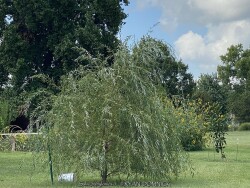

***Tree descriptions available with future update!*** Salix x pendulina 'Blanda' is also known as Wisconsin Weeping Willow
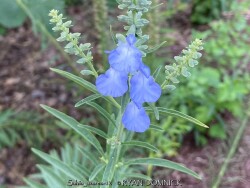

***Description for this plant available with future update!*** Salvia azurea is also known as Blue Sage / Pitcher's Sage.
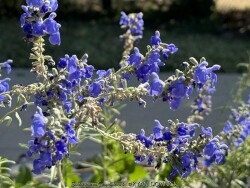

***Description for this plant available with future update!*** Salvia azurea var. grandiflora is also known as Grandiflora Blue Sage / Pitcher's Sage.
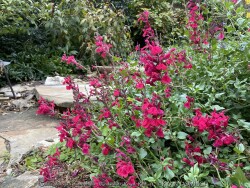

***Description for this perennial available with future update!*** Salvia darcyi x microphylla 'Windwalker Royal Red' is also known as Windwalker Royal Red Autumn Sage >>>>>>>>>>>>Red sage is a wonderful heavily flowering perennial found in Texas and higher election Mexico. Foliage is evergreen to about 0°, Beyond that, it becomes a deciduous perennial hardy to about -15 before complete death would occur. During years in which the foliage remains evergreen, and blooms on old word covering the plants during the month of April. If dieback occurs, blooms will still be dramatic but will be delayed until May on new growth. If Diback does not occur naturally, it is recommended to cut back anyways every 2 to 3 years to maintain bushiness. During the summer, foliage maintains very well with heat and drought with sporadic blooming. Another flush of heavy flowering occurs in fall and continues until hard freezes sometimes into November in our Lawrence Kansas zone6 climate. In the landscape, Red Sage is best on a hot south or west side of a house, on a south side of a berm, or any sunny garden area with some North wind protection. The flower power is so great that it would even be worth using red sage as a short-lived perennial or annual though. Growth in containers is amazing when used as an annual. As with any zone6 perennials, be sure to mulch 2 to 3 inches deep to guard against temperatures below -10F. Red sage needs well drained soils on the dry side but summer irrigation is OK. There is quite a bit of variability within the salvia Greggy species with lots of different colors and heights ranging from 1 to 4 feet. This is a true butterfly magnet; I have seen hundreds of yellow sulfur butterflies visiting at the same time as shown in one of our pictures.
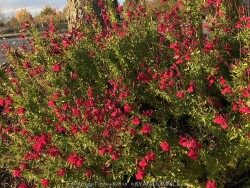

***Description for this perennial available with future update!*** Salvia greggii 'Furmans Red' is also known as Furmans Red Autumn Sage >>>>>>>>>>>>In Lawrence, KS (zone 6a), many dozen established specimens survived -17 degrees F. During the arctic blast of February, 2021, lows down to -17 degrees F on Feb 16th, 2021 were recorded. The longevity of this cold blast was also impressive: 10 days on a row with highs of 10-15 degrees F or lower, 8 nights of lows in the single digits and negatives, and 36 strait hours of 0 degrees F and mostly lower. All survivors had winter sun with South exposures, those without perrished. Repeated or successive cold winters with complete foliage loss seem can be an issue with this and many evergreen zone 6/7 plants. One occasional difficult winter followed by mild winters is more tolerable. This is, however, a very vigorous growing plant so generally will recover in one summer. Avoid North-facing exposures, North sides of a berm, and spots with excessive snow accumulation.
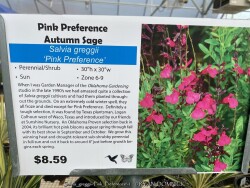

***Description for this perennial available with future update!*** Salvia greggii 'Pink Preference' is also known as Pink Preference Autumn Sage >>>>>>>>>>>>In Eastern Kansas, this cultivar performs WELL with just about everything nature has to challenge it! Extreme heat and drought are tolerated. Cold tolerance is no problem in our zone 6. If winter die-back occurs, cut back in March/April and flowers will occur on new growth this year. No disease or pest problems. Great plant for berms, hot West or South exposures, and most any other garden situations in full sun. Will tolerate clay soils and extra moisture in summer. Combine with caryopteris, crapemyrtle, and butterflybush to create a late season "all you can eat" buffet for pollinators!
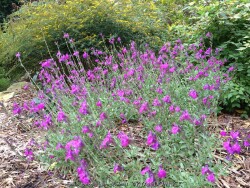

***Description for this perennial available with future update!***Ultra Violet Autumn Sage, is also known as Salvia greggii 'Ultra Violet'
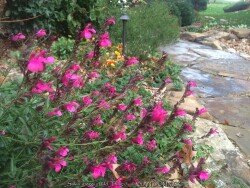

***Description for this perennial available with future update!*** Salvia greggii 'Wild Thing' is also known as Wild Thing Magenta Autumn Sage >>>>>>>>>>>>In Eastern Kansas, this cultivar performs WELL with just about everything nature has to challenge it! Extreme heat and drought are tolerated. Cold tolerance is no problem in our zone 6. If winter die-back occurs, cut back in March/April and flowers will occur on new growth this year. No disease or pest problems. Great plant for berms, hot West or South exposures, and most any other garden situations in full sun. Will tolerate clay soils and extra moisture in summer. Combine with caryopteris, crapemyrtle, and butterflybush to create a late season "all you can eat" buffet for pollinators!
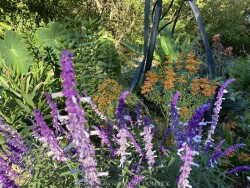

***Description for this plant available with future update!*** Salvia leucantha is also known as Mexican Bush Sage (Tropical).
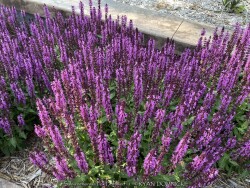

***Description for this perennial available with future update!*** Salvia nemorosa 'Pink Profusion' is also known as Pink Profusion Salvia >>>>>>>>>>>>Enjoy these flowers again and again throughout the summer with rebloom! Dark pink flowers are produced on darker pink calyxes on a perfectly rounded, dense and beautiful habit.>>>>>All Proven Winners® plants are legally propagated, healthy and vigorous, true to name, and tagged with color pictures and growing information.
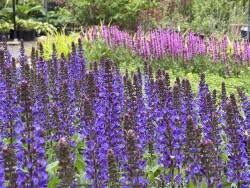

***Description for this perennial available with future update!*** Salvia nemorosa 'Violet Profusion' is also known as Violet Profusion Salvia >>>>>>>>>>>>Enjoy these flowers again and again throughout the summer with rebloom! Violet blue flowers are produced on rosy purple calyxes on a perfectly rounded, dense and beautiful habit.>>>>>>>>>All Proven Winners® plants are legally propagated, healthy and vigorous, true to name, and tagged with color pictures and growing information.
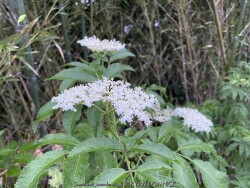

American Elderberry (Sambucus canadensis) is a large spreading shrub with interesting foliage, white flowers and deep purple blackberries. Elderberry is native to a large part of the US (Eastern Midwestern and Northern areas) including Kansas. Large white flower clusters attract bees and other kinds of pollinators for about a month in June. Decent growth will occur in both sun or full shade but growth is open and coarse textured either way. Flowering and fruiting will diminish with increasing shade but not go away completely. American elderberry tolerates a wide variety of wet to dry soils but prefers rich, moist, slightly acidic soil. Elderberry grows fastest and rich well drained soils but may become too fast and agressive. To slow down or eliminate this suckering tendency, plant in a more stressful sites such as dry shade, dry sunny areas, tight heavy clay soils, or non-irrigated areas. However, if you want absorbent amounts of fruit and spread, designate a large area with rich soil regular water in your garden. A favorite use in the landscape is filling the niche of a large flowering shrub in full shade. Elderberry also makes a great mass planting belong roadways or wild areas. Large flowers and copious amounts of fruit make this a great wildlife friendly plant. As you may have already heard, elderberries may be harvested and processed into an array of juices, syrups, and products with immune system stimulating qualities. The raw fruit should be boiled before eaten. Select cultivars have been produced with drastically increased fruit yields. Although self-fertile, more fruit set occurs with cross-polination
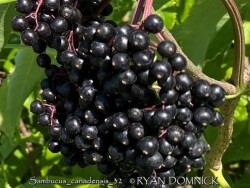

American Elderberry (Sambucus canadensis) is a large spreading shrub with interesting foliage, white flowers and deep purple blackberries. Elderberry is native to a large part of the US (Eastern Midwestern and Northern areas) including Kansas. Large white flower clusters attract bees and other kinds of pollinators for about a month in June. Decent growth will occur in both sun or full shade but growth is open and coarse textured either way. Flowering and fruiting will diminish with increasing shade but not go away completely. American elderberry tolerates a wide variety of wet to dry soils but prefers rich, moist, slightly acidic soil. Elderberry grows fastest and rich well drained soils but may become too fast and agressive. To slow down or eliminate this suckering tendency, plant in a more stressful sites such as dry shade, dry sunny areas, tight heavy clay soils, or non-irrigated areas. However, if you want absorbent amounts of fruit and spread, designate a large area with rich soil regular water in your garden. A favorite use in the landscape is filling the niche of a large flowering shrub in full shade. Elderberry also makes a great mass planting belong roadways or wild areas. Large flowers and copious amounts of fruit make this a great wildlife friendly plant. As you may have already heard, elderberries may be harvested and processed into an array of juices, syrups, and products with immune system stimulating qualities. The raw fruit should be boiled before eaten. Select cultivars have been produced with drastically increased fruit yields. We have tested the following varieties in Lawrence, KS, all passing with flying colors: Bob Gordon, Wyldewood, and York. Although self-fertile, more fruit set occurs with cross-polination.
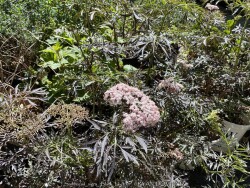

***Shrub descriptions available with future update!*** Sambucus nigra 'Black Lace' is also known as Black Lace Elderberry.
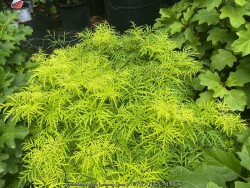

***Shrub descriptions available with future update!*** Sambucus racemosa 'Lemony Lace' is also known as Lemony Lace Elderberry.
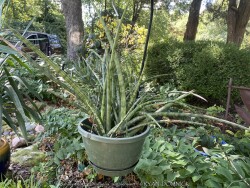

Green tube-like leaves from this Cylindrical Sansevieria (Sansevieria / Dracaena angolensis) make an excellent architectural statement. Most Sansevieria are native to are native to rocky, dry habitats in tropical Africa but used as a patio or house plant in Kansas. Grow in full sun to part sun with optional extra watering including that which comes from rainfall. Plants with plenty of time to acclimate will thrive in full sun but be careful not to rush it or sunburning will occur. Generally if moving outside for the summer, allow 2-3 weeks of part shade or morning sun before placing in full sun. Or just keep in part shade or under an overhang. Repotting may or may not be needed depending on how large you want the plant to grow; plants can continue to grow and tolerate extremely root-bound pots but may need wind bracing. Some species root systems will build up enough pressure and will simply break the pot as a friendly reminder when it's time to re-pot! Protect from temperatures below 45 degrees F and move into a bright window over the winter with no watering. Do not allow Sansevieria to freeze or even get close to freezing especially if soil is wet or death may occur. As a winter house plant, it will look presentable all winter long with just a few monthly or no waterings if you forget. As a permanent house plant, provide bright light and allow the soil to dry between waterings for many years of carefree enjoyment. Potted plants are very low maintenance needing only old leaves trimmed once per year. Cylindrical Sansevieria is often grown as a specimen or hanging basket plant.
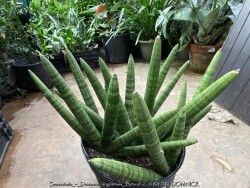

Dwarf green tube-like leaves from this Starfish Sansevieria (Sansevieria / Dracaena angolensis 'Boncel') make an excellent architectural statement. Most Sansevieria are native to are native to rocky, dry habitats in tropical Africa but used as a patio or house plant in Kansas. Grow in full sun to part sun with optional extra watering including that which comes from rainfall. Plants with plenty of time to acclimate will thrive in full sun but be careful not to rush it or sunburning will occur. Generally if moving outside for the summer, allow 2-3 weeks of part shade or morning sun before placing in full sun. Or just keep in part shade or under an overhang. Repotting may or may not be needed depending on how large you want the plant to grow; plants can continue to grow and tolerate extremely root-bound pots but may need wind bracing. Some species root systems will build up enough pressure and will simply break the pot as a friendly reminder when it's time to re-pot! Protect from temperatures below 45 degrees F and move into a bright window over the winter with no watering. Do not allow Sansevieria to freeze or even get close to freezing especially if soil is wet or death may occur. As a winter house plant, it will look presentable all winter long with just a few monthly or no waterings if you forget. As a permanent house plant, provide bright light and allow the soil to dry between waterings for many years of carefree enjoyment. Potted plants are very low maintenance needing only old leaves trimmed once per year. Starfish Sansevieria is one of the more slow-growing and most sought-after snake plants often grown as a specimen house plant. Starfish is relatively rare and will command a higher price than most other houseplants.
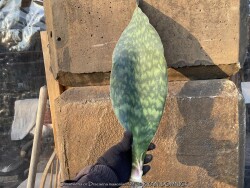

Extra wide blue-green speckled leaves from this Whale Fin Sansevieria (Sansevieria / Dracaena masoniana) make an excellent architectural statement. Most Sansevieria are native to are native to rocky, dry habitats in tropical Africa but used as a patio or house plant in Kansas. Grow in full sun to part sun with optional extra watering including that which comes from rainfall. Plants with plenty of time to acclimate will thrive in full sun but be careful not to rush it or sunburning will occur. Generally if moving outside for the summer, allow 2-3 weeks of part shade or morning sun before placing in full sun. Or just keep in part shade or under an overhang. Repotting may or may not be needed depending on how large you want the plant to grow; plants can continue to grow and tolerate extremely root-bound pots but may need wind bracing. Some species root systems will build up enough pressure and will simply break the pot as a friendly reminder when it's time to re-pot! Protect from temperatures below 45 degrees F and move into a bright window over the winter with no watering. Do not allow Sansevieria to freeze or even get close to freezing especially if soil is wet or death may occur. As a winter house plant, it will look presentable all winter long with just a few monthly or no waterings if you forget. As a permanent house plant, provide bright light and allow the soil to dry between waterings for many years of carefree enjoyment. Potted plants are very low maintenance needing only old leaves trimmed once per year. Whale Fin Sansevieria is one of the more slow-growing and most sought-after snake plants often grown as a specimen house plant. Largest leaves of all sansevierias! Whale Fin is rare and will command a higher price than most other houseplants.
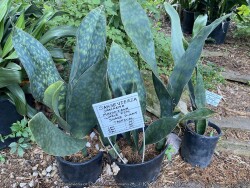

Extra wide blue-green speckled leaves from this Whale Fin Sansevieria (Sansevieria / Dracaena masoniana) make an excellent architectural statement. Most Sansevieria are native to are native to rocky, dry habitats in tropical Africa but used as a patio or house plant in Kansas. Grow in full sun to part sun with optional extra watering including that which comes from rainfall. Plants with plenty of time to acclimate will thrive in full sun but be careful not to rush it or sunburning will occur. Generally if moving outside for the summer, allow 2-3 weeks of part shade or morning sun before placing in full sun. Or just keep in part shade or under an overhang. Repotting may or may not be needed depending on how large you want the plant to grow; plants can continue to grow and tolerate extremely root-bound pots but may need wind bracing. Some species root systems will build up enough pressure and will simply break the pot as a friendly reminder when it's time to re-pot! Protect from temperatures below 45 degrees F and move into a bright window over the winter with no watering. Do not allow Sansevieria to freeze or even get close to freezing especially if soil is wet or death may occur. As a winter house plant, it will look presentable all winter long with just a few monthly or no waterings if you forget. As a permanent house plant, provide bright light and allow the soil to dry between waterings for many years of carefree enjoyment. Potted plants are very low maintenance needing only old leaves trimmed once per year. Whale Fin Sansevieria is one of the more slow-growing and most sought-after snake plants often grown as a specimen house plant. Largest leaves of all sansevierias! Whale Fin is rare and will command a higher price than most other houseplants.
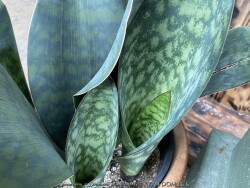

Extra wide blue-green speckled leaves from this Whale Fin Sansevieria (Sansevieria / Dracaena masoniana) make an excellent architectural statement. Most Sansevieria are native to are native to rocky, dry habitats in tropical Africa but used as a patio or house plant in Kansas. Grow in full sun to part sun with optional extra watering including that which comes from rainfall. Plants with plenty of time to acclimate will thrive in full sun but be careful not to rush it or sunburning will occur. Generally if moving outside for the summer, allow 2-3 weeks of part shade or morning sun before placing in full sun. Or just keep in part shade or under an overhang. Repotting may or may not be needed depending on how large you want the plant to grow; plants can continue to grow and tolerate extremely root-bound pots but may need wind bracing. Some species root systems will build up enough pressure and will simply break the pot as a friendly reminder when it's time to re-pot! Protect from temperatures below 45 degrees F and move into a bright window over the winter with no watering. Do not allow Sansevieria to freeze or even get close to freezing especially if soil is wet or death may occur. As a winter house plant, it will look presentable all winter long with just a few monthly or no waterings if you forget. As a permanent house plant, provide bright light and allow the soil to dry between waterings for many years of carefree enjoyment. Potted plants are very low maintenance needing only old leaves trimmed once per year. Whale Fin Sansevieria is one of the more slow-growing and most sought-after snake plants often grown as a specimen house plant. Largest leaves of all sansevierias! Whale Fin is rare and will command a higher price than most other houseplants.
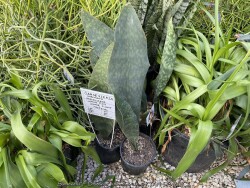

Extra wide blue-green speckled leaves from this Whale Fin Sansevieria (Sansevieria / Dracaena masoniana) make an excellent architectural statement. Most Sansevieria are native to are native to rocky, dry habitats in tropical Africa but used as a patio or house plant in Kansas. Grow in full sun to part sun with optional extra watering including that which comes from rainfall. Plants with plenty of time to acclimate will thrive in full sun but be careful not to rush it or sunburning will occur. Generally if moving outside for the summer, allow 2-3 weeks of part shade or morning sun before placing in full sun. Or just keep in part shade or under an overhang. Repotting may or may not be needed depending on how large you want the plant to grow; plants can continue to grow and tolerate extremely root-bound pots but may need wind bracing. Some species root systems will build up enough pressure and will simply break the pot as a friendly reminder when it's time to re-pot! Protect from temperatures below 45 degrees F and move into a bright window over the winter with no watering. Do not allow Sansevieria to freeze or even get close to freezing especially if soil is wet or death may occur. As a winter house plant, it will look presentable all winter long with just a few monthly or no waterings if you forget. As a permanent house plant, provide bright light and allow the soil to dry between waterings for many years of carefree enjoyment. Potted plants are very low maintenance needing only old leaves trimmed once per year. Whale Fin Sansevieria is one of the more slow-growing and most sought-after snake plants often grown as a specimen house plant. Largest leaves of all sansevierias! Whale Fin is rare and will command a higher price than most other houseplants.
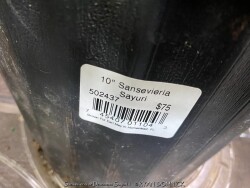

Mint green and white leaves from this Sansevieria (Sansevieria / Dracaena Sayuri) make an excellent architectural statement. Most Sansevieria are native to are native to rocky, dry habitats in tropical Africa but used as a patio or house plant in Kansas. Grow in full sun to part sun with optional extra watering including that which comes from rainfall. Plants with plenty of time to acclimate will thrive in full sun but be careful not to rush it or sunburning will occur. Generally if moving outside for the summer, allow 2-3 weeks of part shade or morning sun before placing in full sun. Or just keep in part shade or under an overhang. Repotting may or may not be needed depending on how large you want the plant to grow; plants can continue to grow and tolerate extremely root-bound pots but may need wind bracing. Some species root systems will build up enough pressure and will simply break the pot as a friendly reminder when it's time to re-pot! Protect from temperatures below 45 degrees F and move into a bright window over the winter with no watering. Do not allow Sansevieria to freeze or even get close to freezing especially if soil is wet or death may occur. As a winter house plant, it will look presentable all winter long with just a few monthly or no waterings if you forget. As a permanent house plant, provide bright light and allow the soil to dry between waterings for many years of carefree enjoyment. Potted plants are very low maintenance needing only old leaves trimmed once per year. This is the basic big-box store sansevieria is often grown as a house plant.
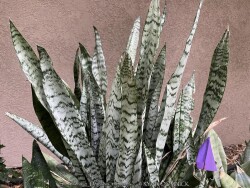

Green to light green leaves from this Sansevieria (Sansevieria / Dracaena trifasciata) make an excellent architectural statement. Most Sansevieria are native to are native to rocky, dry habitats in tropical Africa but used as a patio or house plant in Kansas. Grow in full sun to part sun with optional extra watering including that which comes from rainfall. Plants with plenty of time to acclimate will thrive in full sun but be careful not to rush it or sunburning will occur. Generally if moving outside for the summer, allow 2-3 weeks of part shade or morning sun before placing in full sun. Or just keep in part shade or under an overhang. Repotting may or may not be needed depending on how large you want the plant to grow; plants can continue to grow and tolerate extremely root-bound pots but may need wind bracing. Some species root systems will build up enough pressure and will simply break the pot as a friendly reminder when it's time to re-pot! Protect from temperatures below 45 degrees F and move into a bright window over the winter with no watering. Do not allow Sansevieria to freeze or even get close to freezing especially if soil is wet or death may occur. As a winter house plant, it will look presentable all winter long with just a few monthly or no waterings if you forget. As a permanent house plant, provide bright light and allow the soil to dry between waterings for many years of carefree enjoyment. Potted plants are very low maintenance needing only old leaves trimmed once per year. This is the basic big-box store sansevieria is often grown as a house plant.
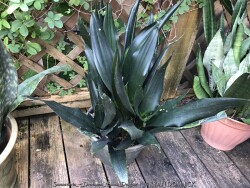

Dark solid green leaves from this Sansevieria (Sansevieria / Dracaena trifasciata 'Black Dragon') make an excellent architectural statement. Most Sansevieria are native to are native to rocky, dry habitats in tropical Africa but used as a patio or house plant in Kansas. Grow in full sun to part sun with optional extra watering including that which comes from rainfall. Plants with plenty of time to acclimate will thrive in full sun but be careful not to rush it or sunburning will occur. Generally if moving outside for the summer, allow 2-3 weeks of part shade or morning sun before placing in full sun. Or just keep in part shade or under an overhang. Repotting may or may not be needed depending on how large you want the plant to grow; plants can continue to grow and tolerate extremely root-bound pots but may need wind bracing. Some species root systems will build up enough pressure and will simply break the pot as a friendly reminder when it's time to re-pot! Protect from temperatures below 45 degrees F and move into a bright window over the winter with no watering. Do not allow Sansevieria to freeze or even get close to freezing especially if soil is wet or death may occur. As a winter house plant, it will look presentable all winter long with just a few monthly or no waterings if you forget. As a permanent house plant, provide bright light and allow the soil to dry between waterings for many years of carefree enjoyment. Potted plants are very low maintenance needing only old leaves trimmed once per year. Black Dragon Sansevieria is one of the more slow-growing and most sought-after snake plants often grown as a specimen house plant.
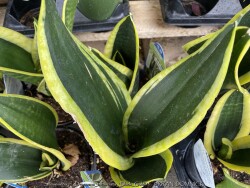

Dark green and gold striped leaves from this Sansevieria (Sansevieria / Dracaena trifasciata 'Black Gold') make an excellent architectural statement. Most Sansevieria are native to are native to rocky, dry habitats in tropical Africa but used as a patio or house plant in Kansas. Grow in full sun to part sun with optional extra watering including that which comes from rainfall. Plants with plenty of time to acclimate will thrive in full sun but be careful not to rush it or sunburning will occur. Generally if moving outside for the summer, allow 2-3 weeks of part shade or morning sun before placing in full sun. Or just keep in part shade or under an overhang. Repotting may or may not be needed depending on how large you want the plant to grow; plants can continue to grow and tolerate extremely root-bound pots but may need wind bracing. Some species root systems will build up enough pressure and will simply break the pot as a friendly reminder when it's time to re-pot! Protect from temperatures below 45 degrees F and move into a bright window over the winter with no watering. Do not allow Sansevieria to freeze or even get close to freezing especially if soil is wet or death may occur. As a winter house plant, it will look presentable all winter long with just a few monthly or no waterings if you forget. As a permanent house plant, provide bright light and allow the soil to dry between waterings for many years of carefree enjoyment. Potted plants are very low maintenance needing only old leaves trimmed once per year. Black Gold Sansevieria is one of the more slow-growing and most sought-after snake plants often grown as a specimen house plant.
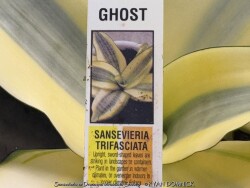

Dwarf whitish yellow variegated leaves from this Moonshine Sansevieria (Sansevieria / Dracaena trifasciata 'Ghost') make an excellent architectural statement. Most Sansevieria are native to are native to rocky, dry habitats in tropical Africa but used as a patio or house plant in Kansas. Grow in full sun to part sun with optional extra watering including that which comes from rainfall. Plants with plenty of time to acclimate will thrive in full sun but be careful not to rush it or sunburning will occur. Generally if moving outside for the summer, allow 2-3 weeks of part shade or morning sun before placing in full sun. Or just keep in part shade or under an overhang. Repotting may or may not be needed depending on how large you want the plant to grow; plants can continue to grow and tolerate extremely root-bound pots but may need wind bracing. Some species root systems will build up enough pressure and will simply break the pot as a friendly reminder when it's time to re-pot! Protect from temperatures below 45 degrees F and move into a bright window over the winter with no watering. Do not allow Sansevieria to freeze or even get close to freezing especially if soil is wet or death may occur. As a winter house plant, it will look presentable all winter long with just a few monthly or no waterings if you forget. As a permanent house plant, provide bright light and allow the soil to dry between waterings for many years of carefree enjoyment. Potted plants are very low maintenance needing only old leaves trimmed once per year. Ghost Sansevieria is one of the more slow-growing and most sought-after snake plants often grown as a specimen house plant.


Compact Green to light green leaves from this Dwarf Sansevieria (Sansevieria / Dracaena trifasciata 'Hahnii') make an excellent architectural statement. Most Sansevieria are native to are native to rocky, dry habitats in tropical Africa but used as a patio or house plant in Kansas. Grow in full sun to part sun with optional extra watering including that which comes from rainfall. Plants with plenty of time to acclimate will thrive in full sun but be careful not to rush it or sunburning will occur. Generally if moving outside for the summer, allow 2-3 weeks of part shade or morning sun before placing in full sun. Or just keep in part shade or under an overhang. Repotting may or may not be needed depending on how large you want the plant to grow; plants can continue to grow and tolerate extremely root-bound pots but may need wind bracing. Some species root systems will build up enough pressure and will simply break the pot as a friendly reminder when it's time to re-pot! Protect from temperatures below 45 degrees F and move into a bright window over the winter with no watering. Do not allow Sansevieria to freeze or even get close to freezing especially if soil is wet or death may occur. As a winter house plant, it will look presentable all winter long with just a few monthly or no waterings if you forget. As a permanent house plant, provide bright light and allow the soil to dry between waterings for many years of carefree enjoyment. Potted plants are very low maintenance needing only old leaves trimmed once per year. This is one of the basic big-box store sansevierias often grown as a house plant.


Green and yellow leaves from this Sansevieria (Sansevieria / Dracaena trifasciata 'Laurentii') make an excellent architectural statement. Most Sansevieria are native to are native to rocky, dry habitats in tropical Africa but used as a patio or house plant in Kansas. Grow in full sun to part sun with optional extra watering including that which comes from rainfall. Plants with plenty of time to acclimate will thrive in full sun but be careful not to rush it or sunburning will occur. Generally if moving outside for the summer, allow 2-3 weeks of part shade or morning sun before placing in full sun. Or just keep in part shade or under an overhang. Repotting may or may not be needed depending on how large you want the plant to grow; plants can continue to grow and tolerate extremely root-bound pots but may need wind bracing. Some species root systems will build up enough pressure and will simply break the pot as a friendly reminder when it's time to re-pot! Protect from temperatures below 45 degrees F and move into a bright window over the winter with no watering. Do not allow Sansevieria to freeze or even get close to freezing especially if soil is wet or death may occur. As a winter house plant, it will look presentable all winter long with just a few monthly or no waterings if you forget. As a permanent house plant, provide bright light and allow the soil to dry between waterings for many years of carefree enjoyment. Potted plants are very low maintenance needing only old leaves trimmed once per year. This is the basic big-box store sansevieria is often grown as a house plant.
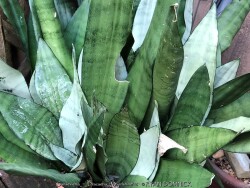

Dwarf whitish green leaves from this Moonshine Sansevieria (Sansevieria / Dracaena trifasciata 'Moonshine') make an excellent architectural statement. Most Sansevieria are native to are native to rocky, dry habitats in tropical Africa but used as a patio or house plant in Kansas. Grow in full sun to part sun with optional extra watering including that which comes from rainfall. Plants with plenty of time to acclimate will thrive in full sun but be careful not to rush it or sunburning will occur. Generally if moving outside for the summer, allow 2-3 weeks of part shade or morning sun before placing in full sun. Or just keep in part shade or under an overhang. Repotting may or may not be needed depending on how large you want the plant to grow; plants can continue to grow and tolerate extremely root-bound pots but may need wind bracing. Some species root systems will build up enough pressure and will simply break the pot as a friendly reminder when it's time to re-pot! Protect from temperatures below 45 degrees F and move into a bright window over the winter with no watering. Do not allow Sansevieria to freeze or even get close to freezing especially if soil is wet or death may occur. As a winter house plant, it will look presentable all winter long with just a few monthly or no waterings if you forget. As a permanent house plant, provide bright light and allow the soil to dry between waterings for many years of carefree enjoyment. Potted plants are very low maintenance needing only old leaves trimmed once per year. Moonshine Sansevieria is one of the more slow-growing and most sought-after snake plants often grown as a specimen house plant.
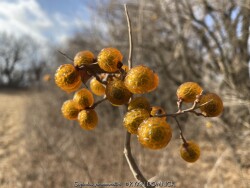

***Tree descriptions available with future update!*** Sapindus drummondii is also known as Western Soapberry
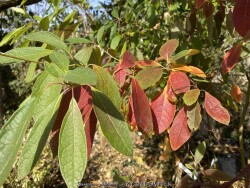

***Tree descriptions available with future update!***Sassafras Tree, is also known as Sassafras albidum


***Description for this hardy tropical available with future update!***>>>>>Voodoo lily is a perennial tuber generally grown as a curiosity for its interesting foliage. The single leaf consists of a stalk (petiole) with mottled pinkish-gray and olive green coloration. The single intricate leaf has horizontal sections giving it a tropical umbrella-like effect. Larger tubers (about the size of a grapefruit or larger) may produce a single "flower" in spring before the foliage appears. The "flower" is actually a large shiny purple to maroon ruffled spathe. When in bloom it produces an odor like a dead animal for 1 day. This is intended to attract the carrion flies that are its natural pollinators. It is possible to overwinter these in the ground in Kansas by placing a 6-12" mound of mulch over deeply planted tubers. New growth will usually be delayed until June but quickly regains full height and will get bigger each year; buried tubers are hardy to zone 6. If growing as a potted patio plant, move into dark garage or basement and keep above 32 Degrees F. Allow to go dormant as needed with little care, just cut off dead foliage and place back out in April or May with a time-release fertilizer.


Lizards Tail Water Plant (Saururus cernuus) is a herbaceous perennial that features clean green foliage and white flowers that bloom in the summer months. Leaves are heart-shaped (cordate) and alternate along the stem of the plant. When the leaves are crushed they release a citrus or sassafras aroma. The native range covers much of the eastern United States including eastern Kansas. This plant is often grown as a marginal aquatic plant in standing water or as a potted plant in water gardens. It can also grow as a bog plant needing constantly moist soil rich in organic matter. As a rain garden plant, it will thrive is a depressed area in the landscape that collects rain water from a roof during spring and summer periods of rain but then go dormant if the water hole dries out completely. It may also be grown in average garden soils provided extra water is supplied during droughts. For the home garden, the species is generally too aggressive to mix with other plants. This can also be a problem in a water garden if you fail to divide this plant after several years. Lizard's Tail is a rare water garden plant that can also tolerate shading by larger trees.
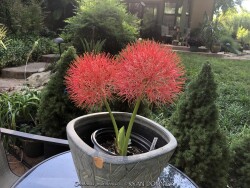

Jaw-dropping flowers! African Blood Lily (Scadoxus multiflorus) produces a mass of tiny florets with prominent stamens clustered in one large, orange-red, softball-sized, bottlebrush, round flower. It is so eye-catching it wins a place in many summer gardens. Reminds me of a giant red dandelion seed head! This South African native is 8"-10" tall and provides bright color in the late summer garden. Bold, broad green leaves emerge after the flowering is over. Although it is said to need partial shade, we have this pest resistant, adaptable plant happily blooming in full sun; blooms mid-summer. Winter hardiness: zones 7/8-10. Plant bulb outside as an annual before flowering: planting already flowered bulbs is not recommended unless you dig it up for winter storage. If grown as a potted plant, bring container indoors and either grow them as a houseplant in a lighted area. Foliage will look good for a few months before finally dying back. Eventually allow bulb to go dormant stopping the water and store bulbs dry in the container with soil anywhere between 40-70 degrees F. African Blood Lily will bloom year after year when grown as a potted plant; late to emerge in the spring so don't throw it out! It is possible to overwinter these in the ground in Kansas by placing a giant 12" mound of mulch over deeply planted bulbs. New growth will usually be delayed until late May/early June but quickly regains full height. In our trial gardens in Lawrence, KS (zone 6a), a bulb planted over 8" deep and next to a South-facing brick wall with 6-8" of leaf mulch survived -17 degrees F. During the arctic blast of February, 2021, lows down to -17 degrees F on Feb 16th, 2021 were recorded. The longevity of this cold blast was also impressive: 10 days on a row with highs of 10-15 degrees F or lower, 8 nights of lows in the single digits and negatives, and 36 straight hours of 0 degrees F and mostly lower.
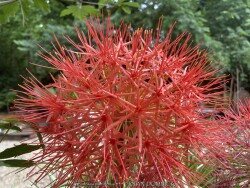

Jaw-dropping flowers! African Blood Lily (Scadoxus multiflorus) produces a mass of tiny florets with prominent stamens clustered in one large, orange-red, softball-sized, bottlebrush, round flower. It is so eye-catching it wins a place in many summer gardens. Reminds me of a giant red dandelion seed head! This South African native is 8"-10" tall and provides bright color in the late summer garden. Bold, broad green leaves emerge after the flowering is over. Although it is said to need partial shade, we have this pest resistant, adaptable plant happily blooming in full sun; blooms mid-summer. Winter hardiness: zones 7/8-10. Plant bulb outside as an annual before flowering: planting already flowered bulbs is not recommended unless you dig it up for winter storage. If grown as a potted plant, bring container indoors and either grow them as a houseplant in a lighted area. Foliage will look good for a few months before finally dying back. Eventually allow bulb to go dormant stopping the water and store bulbs dry in the container with soil anywhere between 40-70 degrees F. African Blood Lily will bloom year after year when grown as a potted plant; late to emerge in the spring so don't throw it out! It is possible to overwinter these in the ground in Kansas by placing a giant 12" mound of mulch over deeply planted bulbs. New growth will usually be delayed until late May/early June but quickly regains full height. In our trial gardens in Lawrence, KS (zone 6a), a bulb planted over 8" deep and next to a South-facing brick wall with 6-8" of leaf mulch survived -17 degrees F. During the arctic blast of February, 2021, lows down to -17 degrees F on Feb 16th, 2021 were recorded. The longevity of this cold blast was also impressive: 10 days on a row with highs of 10-15 degrees F or lower, 8 nights of lows in the single digits and negatives, and 36 straight hours of 0 degrees F and mostly lower.


Little bluestem (Schizachyrium scoparium) is a prominent prairie grass usually found in the short to medium grass prairies of Kansas and most common in the midwest and Great Plains. It also occurs sporadically throughout most of the United States in open areas where trees cannot grow. The spring and summer foliage is mint green to blue green. Depending on the variety, they gradually turn a reddish purple color in late summer progressing to deeper reddish purple, red, or orange by fall. At this time when the seed heads have extended, it is at its prettiest. As cold weather sets in and freezes occur, dried foliage turns a pinkish orange with tan and red shades again depending on the variety. Winter color is persistent and lasts until spring cut back in March. Little bluestem is very tolerant of different soils but prefers dry, sandy, loam, or clay soils with plenty of full sun. If planted in rich soil or given too much water, plants tend to grow too tall and flop by late summer. However, there are now improved cultivars that resist flopping. Good air circulation and some wind is needed to avoid rust diseases in humid areas. Sometimes if planted too shallow or if mulched too thickly, plants can heave and die in the winter. In the landscape, little bluestem looks best when planted in medium to large groups giving the look of a miniature prairie. It also combines very well with many other plants that have different textures and colors. Generally if given the proper placement and growing conditions, little bluestem will last indefinitely. Little bluestem as one of the four major grasses (along with Big bluestem, Indiangrass, and Switchgrass) covering millions of acres and Kansas including the Flint Hills. Where and when conditions are safe, it can be burned in late winter or early spring in a prairie or meadow before new growth appears. Many cultivars have been released improving foliage color and flop resistance.